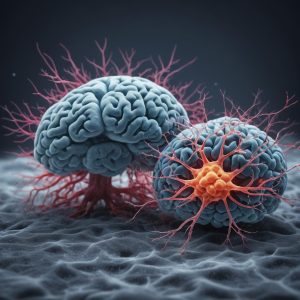
Revolutionary Treatment Reduces Spinal Cord Damage: A Breakthrough in Immunotherapy
In a groundbreaking study published in the esteemed journal Nature, researchers at Washington University School of Medicine have made a monumental discovery that could potentially revolutionize the treatment of spinal cord injuries. By modifying T cells to safeguard damaged neurons, the team has successfully reduced the damage caused by traumatic spinal cord injuries in mice.
Understanding the Role of Immune Cells
The study’s senior author, Jonathan Kipnis, PhD, sheds light on the complex relationship between immune cells and the central nervous system (CNS). “Immune cells have a reputation for being the bad guys that can harm the brain and spinal cord,” he explains. However, this new research reveals that it’s possible to harness their neuroprotective function while controlling their detrimental abilities to help in the recovery from CNS injury.
Modifying T Cells: A Key Component of Immunotherapy
Postdoctoral researcher Wenqing Gao, PhD, played a crucial role in analyzing T cells from the spinal cords of injured mice and identifying those with protective functions. She found that these beneficial T cells can mistakenly attack surrounding tissues when activated for too long, causing autoimmune disease. To improve the therapy’s safety, Gao modified the cells to shut off after a few days.
Clinical Implications and Future Directions
The researchers’ success in reducing spinal cord damage in mice has significant implications for potential human applications. “There are no effective treatments for traumatic injuries to the central nervous system,” notes Gao. The team plans to devise a clinical trial to test the therapy in people with such injuries, while also expanding this work to neurodegenerative diseases like amyotrophic lateral sclerosis (ALS), Alzheimer’s, and Parkinson’s.
A New Era of Immunotherapy
The Washington University study represents a new era in immunotherapy, one that combines cutting-edge genetic engineering techniques with our growing understanding of immune cell behavior. As we continue to push the boundaries of what is possible with gene editing and cell therapy, it becomes increasingly clear that these approaches hold great promise for treating devastating conditions like spinal cord injuries.
Speculative Possibilities: Combining Immunotherapy with Gene Mutation Research
One potential direction for future research could be developing new treatments that target specific genetic mutations associated with spinal cord injuries or other neurological conditions. By combining our understanding of gene function and immune cell behavior, researchers may uncover new therapeutic avenues for treating previously intractable diseases.
As we embark on this new frontier in medical research, it’s essential to acknowledge the risks and challenges associated with these approaches. However, the potential rewards are undeniable: a world where devastating conditions like spinal cord injuries and mental health disorders become manageable, if not curable.
As we continue to explore the possibilities of immunotherapy, it’s essential to consider potential future directions. One area of research that holds great promise is the development of new treatments that target specific genetic mutations associated with spinal cord injuries or other neurological conditions. By leveraging our understanding of gene function and immune cell behavior, researchers may uncover new therapeutic avenues for treating previously intractable diseases.
Another area of research that holds great promise is the use of immunotherapy to treat neurodegenerative diseases like ALS, Alzheimer’s, and Parkinson’s. By harnessing the power of our immune system, researchers may uncover new ways to slow or even halt the progression of these devastating conditions.
The Future of Medicine: Unraveling the Mysteries of Spinal Cord Injuries and Mental Health Disorders
In recent years, breakthroughs in immunotherapy and gene editing have opened up new avenues for treating previously incurable diseases. Two studies, one focusing on spinal cord injuries through T-cell modification and the other delving into mental health disorders via mutated stem cells, have sparked hope that we may finally be able to develop effective cures for these devastating conditions.
Spinal Cord Injuries: Harnessing the Power of Immunology
The researchers at Washington University have been experimenting with modifying T cells to safeguard damaged neurons after spinal cord injuries. This approach is remarkable for its potential to prevent autoimmune disease while still allowing the immune system to protect against infections. By manipulating T cells, these scientists are able to coax them into protecting damaged neurons without inducing an autoimmune response.
Mental Health Disorders: Unraveling the Genetic Code
Meanwhile, the SSPsyGene program is taking a different tack, using mutated stem cells to model mental health disorders. This innovative approach allows researchers to study how specific genetic mutations contribute to these conditions, providing new insights into the underlying mechanisms driving mental illness.
Combining Immunotherapy and Gene Editing: A New Frontier in Treatment
What if we were to combine the immunotherapy approach with the insights gained from studying mutated stem cells in mental health disorders? One potential direction could be developing new treatments that target specific genetic mutations associated with spinal cord injuries or other neurological conditions. By leveraging our understanding of gene function and immune cell behavior, researchers may uncover new therapeutic avenues for treating previously intractable diseases.
Risks and Challenges: Balancing Individual Genetic Variability
Of course, there are also risks and challenges associated with these approaches – the possibility of off-target effects, unforeseen consequences, and the need to balance individual genetic variability with the needs of the population. However, I believe that both studies represent a significant step forward in our understanding of human biology and disease.
The National Institute of Mental Health’s SSPsyGene Program
The National Institute of Mental Health’s SSPsyGene program aims to investigate the roles of specific genes in mental health disorders by using stem cells modified to mimic these genetic variations. Researchers have tested 23 neurodevelopmental and psychiatric disorder (NPD) risk genes, with the goal of understanding how alterations in these genes contribute to NPD.
Key Points:
1. The SSPsyGene program brings together top researchers to study 250 high-risk genes believed to contribute to NPD.
2. Researchers have developed a method for mutating NPD risk genes in human stem cells at large scale.
3. The modified stem cells can be turned into neurons and other brain cells to model the consequences of risk gene mutations.
4. The resulting stem cell lines will be made available to other researchers worldwide to facilitate research on those risk genes and their contribution to NPD.
Controversy:
Some critics argue that this approach is too reductionist, focusing solely on genetic factors rather than considering broader environmental and cultural influences on mental health. They also point out that cells in tissue culture do not behave like cells in a real brain, making it difficult to translate findings from lab-based models to real-world scenarios.
Conclusion:
The SSPsyGene program represents a significant step forward in understanding the genetic basis of NPD. While some critics raise valid concerns about the limitations of this approach, the potential benefits of unraveling the genetic causes of mental illness cannot be overstated. As researchers continue to refine their methods and consider multiple perspectives on mental health, we may finally begin to develop more effective treatments for these devastating disorders.
As we continue to push the boundaries of what is possible in medicine, it is clear that immunotherapy and gene editing will play a crucial role in unraveling the mysteries of spinal cord injuries and mental health disorders. By combining these approaches and considering multiple perspectives on disease, we may finally begin to develop effective cures for these devastating conditions.






What an incredible breakthrough in the field of immunology! The potential implications of this research are staggering – reducing spinal cord damage and potentially even treating mental health disorders through immunotherapy. As a geneticist, I’m particularly fascinated by the idea of harnessing the power of immune cells to protect damaged neurons.
But what if we take it a step further? What if we could use this knowledge to develop new treatments that target specific genetic mutations associated with spinal cord injuries or other neurological conditions? The possibilities are endless, and I believe this is an area of research that holds great promise for the future of medicine.
One question that comes to mind is: How might this research impact our understanding of mental health disorders? Could we use immunotherapy to treat conditions like depression or anxiety by targeting specific genetic mutations? It’s a fascinating prospect, and one that I’d love to explore further.
Isaiah, your enthusiasm is admirable, but let’s not get carried away with the possibilities. As we’re seeing in real-time today with Israeli strikes on Gaza mosque and school killing 26 people, including children, the world still has a long way to go before we can say that science has truly cured all of humanity’s problems.
While immunotherapy may hold promise for treating mental disorders, let’s not forget that it’s just one piece of the puzzle. We need to consider the root causes of these disorders, which are often deeply ingrained in our societal and cultural norms.
Moreover, your suggestion that we could target specific genetic mutations associated with spinal cord injuries or other neurological conditions glosses over the complexity of human biology. We’re not dealing with a simple switch that can be flipped on or off; we’re dealing with intricate systems that have evolved over millions of years.
Let’s also consider the ethical implications of this research. If we start playing around with genetic mutations, where do we draw the line? Who decides what traits are desirable and which ones are not?
I’m not saying that immunotherapy isn’t an interesting area of research, but let’s keep things in perspective and not get too caught up in the hype.
What a joke! Anthropic’s CEO thinks he can predict the future with his naive techno-optimism? Meanwhile, researchers are actually making groundbreaking discoveries in immunotherapy that could potentially cure mental disorders. The irony is staggering. I’m sure his predictions of AI utopia will be just as laughable when they’re proven wrong by the reality of AI-induced societal collapse. How long until we can harness the power of immunotherapy to treat the impending existential crisis caused by unchecked technological advancement?